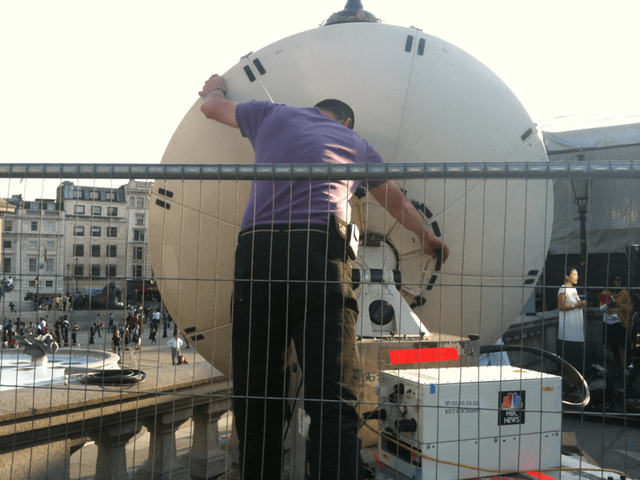The original question here was an inquiry for an inexpensive meter. I understand this, but please allow me to go from one extreme to the other in this regard.
When I first started in the FTA hobby I did not use a meter of any sort. My first FTA receiver was the Coolsat 5000 (which I still own and use today). I researched the satellites available to my area through Lyngsat and SatCoDX and manually entered them in the Coolsat receiver. I then took the advice and instructions from the Masters and the Gurus regarding how to set up and align the satellite dish. In the beginning, I did not have a motorized system, only one fixed point dish which I aimed at 97.0°W (IA-5 at that time - now Galaxy 19).
I rolled out an extension cord to where my dish was planted and set up the Coolsat and my TV right there. I then used the manual scan mode of the Coolsat to select the satellite and the transponder that I wanted to dial in on. With the Coolsat and TV waiting to receive that signal, I set the dish assembly up for the nearest appropriate angles of elevation and LNBF polarization and focal position. I then manually panned the dish east to west and west to east in the general "window" for where I knew the satellite should be until I detected a "blip" on the Coolsat meter.
With some minor fine tuning of the dish I brought that quality level up to a point where I could scan what I found. I performed a manual scan of that particular signal and compared the channels logged in to what Lyngsat showed should be there.
My first attempt proved accurate and I knew I was aligned to the proper satellite. So I then "tweaked and peaked" the dish and the LNBF for the best quality and scanned the entire satellite.
From this, you can deduce that you don't require a meter at all. All you really require is a fairly decent FTA receiver with a fairly responsive signal quality meter (one that locks onto the signal quickly), a good knowledge of what you are doing ahead of time and plenty of patience and a really nice day.
Now, allow me to take this all the way to the other end of the spectrum by suggesting a high dollar meter - The SuperBuddy Meter from Applied Instruments.
If you want to really have a LOT of FUN with this hobby or if you are going into business setting up satellite dishes, you MUST consider this meter.
It is expensive, I understand that. About $700. If that figure scares the heck out of you, then you probably don't want to go here. But, allow me to try to explain why it is so expensive.
This meter is not a toy.
It is not an "el-cheapo" freebie meter that you would get with the purchase of a satellite receiver as a "thank you for buying from us" gift. This is a major, high quality instrument that is just as much fun to use as it is versatile. You name it... What do you want your meter to do? It does it. FTA? It does it! DishNetwork? It does it! DirecTV? It does it! BellExpress? It does it! Wild Blue internet? It does it! HughesNet? It does it! Cable quality analyzer? It does it! Spectrum analyzer? It does it! Upgradeable? Yes! Manually programmable? YES! World class support for repair and upgrades? You Bet!
I have owned my SuperBuddy meter for five or six years now. This is one item that I have purchased that, although a high dollar instrument, I have been extremely pleased with all the way. I don't regret one penny of the cost as it has been a true "SuperBuddy" to me! I no longer have to haul a receiver and a TV and an extension cord out to the dish to do my job.
Not only does it make my own hobby easy and fun, but when I want to set up a system for a friend or neighbor, I can do so quickly and easily that I leave them in amazement.
Some of my friends ask me to help them out with realigning their DishNetwork or DirecTV dishes when they need to repair their roofs or when they are remodeling their homes. I can do this with the SuperBuddy meter and I can dial their dish in much better than the original technician did when it was first installed. Yep, I can actually brag about my FTA installations and my retweaks of existing systems. I attribute much of this capability to the SuperBuddy meter.
The installation technicians for DISH, Bell and DirecTV, WildBlue and HughesNet, etc, should have this meter. It sincerely is that good.
If you have the money to spend on this meter, I can personally recommend it. If you are in business to install satellite dishes for almost any purpose, your technicians should have this meter at their disposal. You will have to investigate all the other things that it can do as I can only scratch the surface.
To summarize... If you are just playing around your home with your FTA hobby, there is no need to dabble with a meter. You can accomplish your goals with your receiver and save yourself money if you understand what you are doing. On the other hand, if you are really into this hobby and you don't mind spending a few bucks, buy something that you will be proud of and something that will last. Oh, and the SuperBuddy is made in the USA! (Indiana)
RADAR



